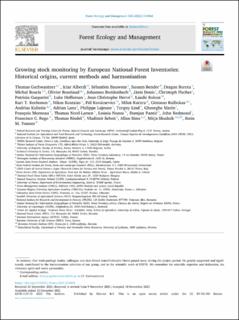Growing stock monitoring by European National Forest Inventories: Historical origins, current methods and harmonisation
| dc.contributor.author | Gschwantner, Thomas | |
| dc.contributor.author | Alberdi, Iciar | |
| dc.contributor.author | Bauwens, Sébastien | |
| dc.contributor.author | Bender, Susann | |
| dc.contributor.author | Borota, Dragan | |
| dc.contributor.author | Bosela, Michal | |
| dc.contributor.author | Bouriaud, Olivier | |
| dc.contributor.author | Breidenbach, Johannes | |
| dc.contributor.author | Donis, Jānis | |
| dc.contributor.author | Fischer, Christoph | |
| dc.contributor.author | Gasparini, Patrizia | |
| dc.contributor.author | Heffernan, Luke | |
| dc.contributor.author | Hervé, Jean-Christophe | |
| dc.contributor.author | Kolozs, László | |
| dc.contributor.author | Korhonen, Kari T. | |
| dc.contributor.author | Koutsias, Nikos | |
| dc.contributor.author | Kovácsevics, Pál | |
| dc.contributor.author | Kučera, Miloš | |
| dc.contributor.author | Kulbokas, Gintaras | |
| dc.contributor.author | Kuliešis, Andrius | |
| dc.contributor.author | Lanz, Adrian | |
| dc.contributor.author | Lejeune, Philippe | |
| dc.contributor.author | Lind, Torgny | |
| dc.contributor.author | Marin, Gheorghe | |
| dc.contributor.author | Morneau, François | |
| dc.contributor.author | Nord-Larsen, Thomas | |
| dc.contributor.author | Nunes, Leónia | |
| dc.contributor.author | Pantić, Damjan | |
| dc.contributor.author | Redmond, John | |
| dc.contributor.author | Rego, Francisco C. | |
| dc.contributor.author | Riedel, Thomas | |
| dc.contributor.author | Šebeň, Vladimír | |
| dc.contributor.author | Sims, Allan | |
| dc.contributor.author | Skudnik, Mitja | |
| dc.contributor.author | Tomter, Stein Michael | |
| dc.date.accessioned | 2022-07-15T08:27:13Z | |
| dc.date.available | 2022-07-15T08:27:13Z | |
| dc.date.created | 2022-05-06T15:00:05Z | |
| dc.date.issued | 2021-12-12 | |
| dc.identifier.citation | Forest Ecology and Management. 2022, 505 . | en_US |
| dc.identifier.issn | 0378-1127 | |
| dc.identifier.uri | https://hdl.handle.net/11250/3005681 | |
| dc.description.abstract | Wood resources have been essential for human welfare throughout history. Also nowadays, the volume of growing stock (GS) is considered one of the most important forest attributes monitored by National Forest Inventories (NFIs) to inform policy decisions and forest management planning. The origins of forest inventories closely relate to times of early wood shortage in Europe causing the need to explore and plan the utilisation of GS in the catchment areas of mines, saltworks and settlements. Over time, forest surveys became more detailed and their scope turned to larger areas, although they were still conceived as stand-wise inventories. In the 1920s, the first sample-based NFIs were introduced in the northern European countries. Since the earliest beginnings, GS monitoring approaches have considerably evolved. Current NFI methods differ due to country-specific conditions, inventory traditions, and information needs. Consequently, GS estimates were lacking international comparability and were therefore subject to recent harmonisation efforts to meet the increasing demand for consistent forest resource information at European level. As primary large-area monitoring programmes in most European countries, NFIs assess a multitude of variables, describing various aspects of sustainable forest management, including for example wood supply, carbon sequestration, and biodiversity. Many of these contemporary subject matters involve considerations about GS and its changes, at different geographic levels and time frames from past to future developments according to scenario simulations. Due to its historical, continued and currently increasing importance, we provide an up-to-date review focussing on large-area GS monitoring where we i) describe the origins and historical development of European NFIs, ii) address the terminology and present GS definitions of NFIs, iii) summarise the current methods of 23 European NFIs including sampling methods, tree measurements, volume models, estimators, uncertainty components, and the use of air- and space-borne data sources, iv) present the recent progress in NFI harmonisation in Europe, and v) provide an outlook under changing climate and forest-based bioeconomy objectives. | en_US |
| dc.language.iso | eng | en_US |
| dc.publisher | Elsevier B.V. | en_US |
| dc.rights | Attribution-NonCommercial-NoDerivatives 4.0 Internasjonal | * |
| dc.rights.uri | http://creativecommons.org/licenses/by-nc-nd/4.0/deed.no | * |
| dc.title | Growing stock monitoring by European National Forest Inventories: Historical origins, current methods and harmonisation | en_US |
| dc.title.alternative | Growing stock monitoring by European National Forest Inventories: Historical origins, current methods and harmonisation | en_US |
| dc.type | Peer reviewed | en_US |
| dc.type | Journal article | en_US |
| dc.description.version | publishedVersion | en_US |
| dc.rights.holder | © 2021 The Authors | en_US |
| dc.source.pagenumber | 22 | en_US |
| dc.source.volume | 505 | en_US |
| dc.source.journal | Forest Ecology and Management | en_US |
| dc.identifier.doi | 10.1016/j.foreco.2021.119868 | |
| dc.identifier.cristin | 2022213 | |
| dc.relation.project | EC/H2020/633464 | en_US |
| dc.source.articlenumber | 119868 | en_US |
| cristin.ispublished | true | |
| cristin.fulltext | original | |
| cristin.qualitycode | 2 |
Files in this item
This item appears in the following Collection(s)
-
Divisjon for skog og utmark [520]
Publikasjoner knyttet til ansatte ved Divisjon for skog og utmark -
Publikasjoner fra CRIStin - NIBIO [4554]
-
Vitenskapelige artikler [1416]

